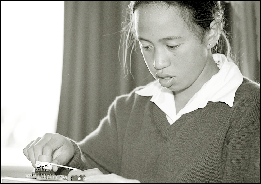| ACKNOWLEDGEMENTS |
• the very dedicated staff of the Educational Assessment Research Unit
• Dr Hans Wagemaker and Mr James Irving, Ministry of Education
• members of the Project's National Advisory Committee
• members of the Project's Technology Advisory Panel
• technical consultants, Professor Warwick Elley and Dr Alison Gilmore
• principals, staff, and children of the schools where tasks were trialed
• principals, staff, and Board of Trustees members of the 265 schools included in the 1996 sample
• the 2868 children in the 1996 sample, and their parents
• the 95 teachers who administered the assessments to the children
• the 22 senior tertiary students who assisted with the marking process
• the 150 teachers who assisted with the marking of tasks early in 1997

New Zealand's
National Education Monitoring Project commenced
in 1993, with the task of assessing and reporting on the achievement
of New Zealand primary school children in all areas of the school
curriculum. Children are assessed at two class levels: Year 4 (halfway
through primary education) and Year 8 (at the end of primary education).
Different curriculum areas and skills are assessed each year, over
a four year cycle. The main goal of national monitoring is to provide
detailed information about what children can do so that patterns
of performance can be recognised, successes celebrated, and desirable
changes to educational practices and resources identified and implemented.
Each year, small random samples
of children are selected nationally, then assessed in their own schools
by teachers specially seconded and trained for this work. Task instructions
are given orally by teachers, through video presentations, or in writing.
Many of the assessment tasks involve the children in the use of equipment
and supplies. Their responses are presented orally, by demonstration,
in writing, or through submission of other physical products. Many
of the responses are recorded on videotape for subsequent analysis.
In 1996, the second
year that national monitoring was implemented, four areas were assessed:
music, reading, speaking, and aspects of technology. This report presents
details and results of the assessments relating to aspects of technology.
Because of the breadth of the technology curriculum, and the time consuming
nature of tasks which would be needed to assess some aspects of it, we
explicitly limited our focus to selected aspects.
The assessments revealed wide variations in performance on technology tasks. Tasks involving explanation, design, or evaluation of design were generally not very well handled, but students had greater success with tasks involving observation, description and factual knowledge. Most students were able to use computers to carry out simple tasks. Year 8 students performed better than year 4 students on most aspects of the tasks which were common to both levels.
Responses to the Technology Survey revealed generally positive attitudes towards technology as an activity at school. Not surprisingly, the responses reflected various interpretations of what technology is, not all of which match the emphases in the new technology curriculum. Both year 4 and year 8 students reported that the most common technology activity in school involved using computers. Making or designing was the next most common activity reported at both levels. Many year 8 students also mentioned participation in workshop or manual subjects. Despite the emphasis on computer usage in school, regular use of computers was more common at home than at school, for both year 4 and year 8 students. Nevertheless, 15 to 20 percent of students at both levels only used computers when at school.
Girls and boys performed similarly on most tasks at both levels. Students in schools with high proportions of Mäori students and/or with low socio-economic decile ratings had lower levels of performance than other students on about 40 percent of the tasks. However, there were fewer tasks on which Mäori students performed less well than non-Mäori students, suggesting that the differences may be more due to socio-economic factors affecting schools than to ethnicity.